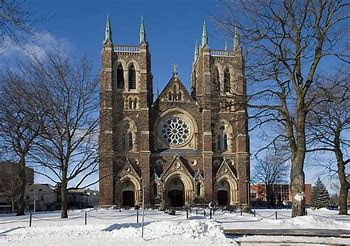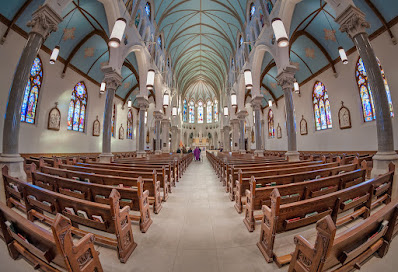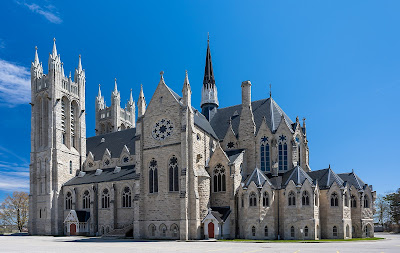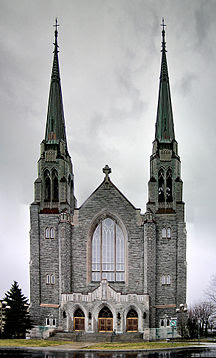Basilicas in Ontario and Western Canada
I blogged about the following basilicas on January 18, 2019.
- Cathedral Basilica of Our Lady of Ottawa, Ottawa, Ontario
- Cathedral Basilica of St. Boniface, Winnipeg, Manitoba
- St. Joseph’s Cathedral Basilica, Edmonton, Alberta
- St. Michael’s Cathedral Basilica, Toronto, Ontario
St. Peter’s Cathedral Basilica, London, Ontario
Declared a minor basilica by Pope John XXIII in 1961.
St. Peter’s began as a log chapel in 1834. The current French Gothic church was built between 1880 and 1885. The twin towers, Lady Chapel, and sacristy were added in 1958. It is the Cathedral for the Diocese of London.
Pictures are from TripAdvisor, Flickr, and Pinterest.
St. Patrick’s Basilica, Ottawa, Ontario
Declared a minor basilica by Pope John Paul II in 1995.
St. Patrick’s parish opened in 1855 to serve English-speaking Catholics, mostly Irish. The current Gothic Revival building was built in the early 1870s. The stenciled ceiling, most of the murals, and some of the stained glass windows were crafted by Guido Nincheri in the 1920s and 1930s. The Cathedral has five choirs.
Pictures are from Wikipedia and Flickr.
St. Paul’s Basilica, Toronto, Ontario
Declared a minor basilica by Pope John Paul II in 1999.
St. Paul’s parish was established in 1822 and is the oldest parish in Toronto. The original church building served as the first Cathedral for Toronto from 1842 to 1848. The current Italian Renaissance church was completed in 1889 based on the design of the Basilica of Saint Paul Outside the Walls in Rome. The Italianate bell tower was built in 1905.
The top two pictures are from Wikipedia, then Pinterest.
Cathedral Basilica of Christ the King, Hamilton, Ontario
Declared a minor basilica by Pope Benedict XVI in 2013.
The Cathedral Basilica of Christ the King was built between 1930 and 1933 and serves as the Cathedral for the Diocese of Hamilton. It is made from limestone and employs a 13th Century English Gothic design. The 165-foot bell tower contains a stone from the Roman catacombs. The church has 82 stained glass windows from the Meyer Company of Munich, Germany, and a 5,000 pipe organ from Steinmeyer in Bavaria. The Stations of the Cross were carved in Italy using Cararra marble.
The first two pictures are from Wikipedia and the last two are from Flickr.
Basilica of Our Lady Immaculate, Guelph, Ontario
Declared a minor basilica by Pope Francis in 2014.
The Gothic Revival church was built between 1876 and 1888 and is constructed with local limestone. The two towers rise to 200 feet above street level. Many of the Basilica’s decorative carvings were done by local artist, Matthew Bell, who fell to his death while working in the Basilica.
The top two pictures are from Flickr and the next two are from Wikipedia.
Basilica of Christ the King, Moosonee, Ontario
Declared a minor basilica by Pope Francis in 2020.
The church served as the cathedral for the Diocese of Moosonee from the church’s completion in 1938 until 2016, when the Diocese was suppressed.
The picture is from Wikipedia.
Basilica of St. Finnan, Alexandria, Ontario
Declared a minor basilica by Pope Francis in 2021.
St. Finnan’s began as a mission in 1832. The current building was built between 1883 and 1885 and served as the Cathedral for the Diocese of Alexandria-Cornwall from 1890 until the Diocese’s suppression in 2020.
The first picture is from Flickr and the second is from the local newspaper.












































